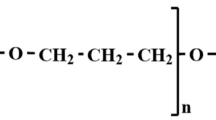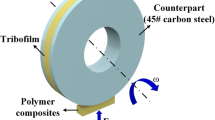Abstract
Excellent cryogenic mechanical properties are urgently requested for the materials used in liquid oxygen environment. However, a DOPO-modified epoxy resin (EP-P), which was compatible with liquid oxygen, had no improved cryogenic mechanical properties compared with the pure epoxy resin (EP). Besides, its mechanical properties at room temperature (RT) were obviously decreased compared with EP. Thus, a novel epoxy-grafted polysiloxane (EGP) was synthesized by dimethyldimethoxysilane, dimethoxydiphenylsilane and 3-glycidoxy-propyltrimethoxysilane through co-hydrolytic condensation reaction. EGP was introduced into EP-P to improve cryogenic mechanical properties, especially toughness of EP-P. Tensile properties and fracture toughness of the DOPO/EGP-modified epoxy resin (EP-P/Si) at RT and liquid oxygen temperature (90 K) were investigated. Compared with EP, at RT, failure strain and KIC of EP-P/Si were increased by about 100% and 40%; at 90 K, the above two properties were increased by about 60% and 50%. Besides, EP-P/Si had almost same tensile strength with EP at both RT and 90 K. The results of the liquid oxygen mechanical impact test indicated that EP-P/Si was still compatible with liquid oxygen. XPS analysis showed that EP-P/Si had lower oxidation degree after the impact test compared with EP-P, indicating that liquid oxygen compatibility was enhanced.







Similar content being viewed by others
References
Nguyen DD, Vu CM, Choi HJ (2018) Improvement of the mode I interlaminar fracture toughness of glass fiber/epoxy composites using polystyrene electrospun nanofibres. Polym Bull 75:5089–5102
He XD, Zhang WC, Yang RJ (2017) The characterization of DOPO/MMT nanocompound and its effect on flame retardancy of epoxy resin. Compos Part A 98:124–135
Lu LG, Zeng ZJ, Qian XD, Shao GS, Wang HY (2019) Thermal degradation and combustion behavior of flame-retardant epoxy resins with novel phosphorus-based flame retardants and silicon particles. Polym Bull 76:3607–3619
Tang S, Wachtendorf V, Klack P, Qian LJ, Dong YP, Schartel B (2017) Enhanced flame-retardant effect of a montmorillonite/phosphaphenanthrene compound in an epoxy thermoset. RSC Adv 7:720–728
Ma C, Qiu SL, Wang JL, Sheng HB, Zhang Y, Hu WZ, Hu Y (2018) Facile synthesis of a novel hyperbranched poly(urethane-phosphine oxide) as an effective modifier for epoxy resin. Polym Degrad Stab 154:157–169
Li JL, Wang HY, Li SC (2019) Thermal stability and flame retardancy of an epoxy resin modified with phosphoric triamide and glycidyl POSS. High Perform Polym. https://doi.org/10.1177/0954008319843979
Hung PY, Lau KT, Qiao K, Fox B, Hameed N (2019) Property enhancement of CFRP composites with different graphene oxide employment methods at a cryogenic temperature. Compos Part A 120:56–63
Praveen RS, Jacob S, Murthy CRL, Balachandran P, Rao YVKS (2011) Hybridization of carbon–glass epoxy composites: an approach to achieve low coefficient of thermal expansion at cryogenic temperatures. Cryogenics 51:95–104
He YX, Yang S, Liu H, Shao Q, Chen QY, Lu C, Jiang YL, Liu CT, Guo ZH (2018) Reinforced carbon fiber laminates with oriented carbon nanotube epoxy nanocomposites: magnetic field assisted alignment and cryogenic temperature mechanical properties. J Colloid Interface Sci 517:40–51
Kim MG, Moon JB, Kim CG (2012) Effect of CNT functionalization on crack resistance of a carbon/epoxy composite at a cryogenic temperature. Compos Part A 43:1620–1627
Wu ZJ, Li SC, Liu MJ, Wang Z, Liu X (2015) Liquid oxygen compatible epoxy resin: modification and characterization. RSC Adv 5:11325–11333
Wu ZJ, Li SC, Liu MJ, Wang HY, Wang Z, Liu X (2016) Study on liquid oxygen compatibility of bromine-containing epoxy resins for the application in liquid oxygen tank. Polym Adv Technol 27:98–108
Wang G, Li XD, Yan R, **ng SL (2006) The study on compatibility of polymer matrix resins with liquid oxygen. Mater Sci Eng, B 132:70–73
Peng C, Gao C, Yuan YH, Wu ZJ, Zhou DY (2018) Synthesis and application of a benzoxazine-type phosphorus-containing monomer on epoxy/benzoxazine copolymer: thermal stability and compatibility with liquid oxygen. Polym Degrad Stab 157:131–142
Robinson MJ, Stoltzfus JM, Owens TN (1997) Composite material compatibility with liquid oxygen. AIAA 1107:973–982
Wu ZJ, Li JL, Chen YP, Wang Z, Li SC (2015) Synthesis and liquid oxygen compatibility of a phosphorous-containing epoxy resin. Polym Eng Sci 55:651–656
Zhang GC, Wen ZJ, Liang SJ, Tan YL, Tian L, Zhao YQ, Zhao DS (2019) Ground response of a gob-side entry in a longwall panel extracting 17 m-thick coal seam: a case study. Rock Mech Rock Eng. https://doi.org/10.1007/s00603-019-01922-5
Feng QP, Deng YH, **ao HM, Liu Y, Qu CB, Zhao Y, Fu SY (2014) Enhanced cryogenic interfacial normal bond property between carbon fibers and epoxy matrix by carbon nanotubes. Compos Sci Technol 104:59–65
Jiang BY, Gu ST, Wang LG, Zhang GC, Li WS (2019) Strainburst process of marble in tunnel-excavation-induced stress path considering intermediate principal stress. J Cent South Univ 26:984–999
Liu Y, Yang G, **ao HM, Feng QP, Fu SY (2013) Mechanical properties of cryogenic epoxy adhesives: effects of mixed curing agent content. Int J Adhes Adhes 41:113–118
Qi Z, Zhang WC, He XD, Yang RJ (2016) High-efficiency flame retardency of epoxy resin composites with perfect T8 caged phosphorus containing polyhedral oligomeric silsesquioxanes (P-POSSs). Compos Sci Technol 127:8–19
Chruściel JJ, Leśniak E (2015) Modification of epoxy resins with functional silanes, polysiloxanes, silsesquioxanes, silica and silicates. Prog Polym Sci 41:67–121
Li S, Li H, Li Z, Zhou H, Guo Y, Chen FH, Zhao T (2017) Polysiloxane modified phenolic resin with co-continuous structure. Polymer 120:217–222
Li JL, Wang HY, Li SC (2019) A novel phosphorus–silicon containing epoxy resin with enhanced thermal stability, flame retardancy and mechanical properties. Polym Degrad Stab 164:36–45
Paluvai NR, Mohanty S, Nayak SK (2015) Studies on thermal degradation and flame retardant behavior of the sisal fiber reinforced unsaturated polyester toughened epoxy nanocomposites. J Appl Polym Sci 132:42068
Jia P, Liu HC, Liu Q, Cai XF (2016) Thermal degradation mechanism and flame retardancy of MQ silicone/epoxy resin composites. Polym Degrad Stab 134:144–150
Chen X, Wang J, Huo SQ, Yang S, Zhang B, Cai HP (2018) Study on properties of flame-retardant cyanate esters modified with DOPO and triazine compounds. Polym Adv Technol 29:2574–2582
Yi XF, Mishra AK, Kim NH, Ku BC, Lee JH (2013) Synergistic effects of oxidized CNTs and reactive oligomer on the fracture toughness and mechanical properties of epoxy. Compos Part A 49:58–67
Zhang WC, Li XM, Yang RJ (2014) Study on the change of silicon and phosphorus content in the condensed phase during the combustion of epoxy resin with OPS/DOPO. Polym Degrad Stab 99:298–303
Zhang WC, Li XM, Fan HB, Yang RJ (2012) Study on mechanism of phosphorus–silicon synergistic flame retardancy on epoxy resins. Polym Degrad Stab 97:2241–2248
Acknowledgements
This work was supported by the Natural Science Foundation of Shandong Province (ZR2018BEM038) and Scientific Research Foundation of Shandong University of Science and Technology for Recruited Talents (2017RCJJ003).
Author information
Authors and Affiliations
Corresponding author
Additional information
Publisher's Note
Springer Nature remains neutral with regard to jurisdictional claims in published maps and institutional affiliations.
Rights and permissions
About this article
Cite this article
Li, JL., Wang, C. & Lu, KY. Enhanced cryogenic mechanical properties and liquid oxygen compatibility of DOPO-containing epoxy resin reinforced by epoxy-grafted polysiloxane. Polym. Bull. 77, 3429–3442 (2020). https://doi.org/10.1007/s00289-019-02931-8
Received:
Revised:
Accepted:
Published:
Issue Date:
DOI: https://doi.org/10.1007/s00289-019-02931-8




